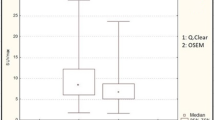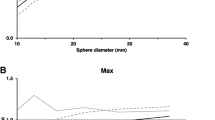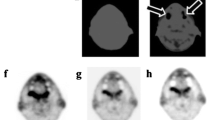Abstract
Purpose
PET/MR has the potential to become a powerful tool in clinical oncological imaging. The purpose of this prospective study was to evaluate the performance of a single T1-weighted (T1w) fat-suppressed unenhanced MR pulse sequence of the abdomen in comparison with unenhanced low-dose CT images to characterize PET-positive lesions.
Methods
A total of 100 oncological patients underwent sequential whole-body 18F-FDG PET with CT-based attenuation correction (AC), 40 mAs low-dose CT and two-point Dixon-based T1w 3D MRI of the abdomen in a trimodality PET/CT-MR system. PET-positive lesions were assessed by CT and MRI with regard to their anatomical location, conspicuity and additional relevant information for characterization.
Results
From among 66 patients with at least one PET-positive lesion, 147 lesions were evaluated. No significant difference between MRI and CT was found regarding anatomical lesion localization. The MR pulse sequence used performed significantly better than CT regarding conspicuity of liver lesions (p < 0.001, Wilcoxon signed ranks test), whereas no difference was noted for extrahepatic lesions. For overall lesion characterization, MRI was considered superior to CT in 40 % of lesions, equal to CT in 49 %, and inferior to CT in 11 %.
Conclusion
Fast Dixon-based T1w MRI outperformed low-dose CT in terms of conspicuity and characterization of PET-positive liver lesions and performed similarly in extrahepatic tumour manifestations. Hence, under the assumption that the technical issue of MR AC for whole-body PET examinations is solved, in abdominal PET/MR imaging the replacement of low-dose CT by a single Dixon-based MR pulse sequence for anatomical lesion correlation appears to be valid and robust.



Similar content being viewed by others
References
Beyer T, Townsend DW, Brun T, Kinahan PE, Charron M, Roddy R, et al. A combined PET/CT scanner for clinical oncology. J Nucl Med. 2000;41:1369–79.
Hany TF, Steinert HC, Goerres GW, Buck A, von Schulthess GK. PET diagnostic accuracy: improvement with in-line PET-CT system: initial results. Radiology. 2002;225:575–81.
Pichler BJ, Kolb A, Nagele T, Schlemmer HP. PET/MRI: paving the way for the next generation of clinical multimodality imaging applications. J Nucl Med. 2010;51:333–6. doi:10.2967/jnumed.109.061853.
Wehrl HF, Judenhofer MS, Wiehr S, Pichler BJ. Pre-clinical PET/MR: technological advances and new perspectives in biomedical research. Eur J Nucl Med Mol Imaging. 2009;36 Suppl 1:S56–68. doi:10.1007/s00259-009-1078-0.
Ratib O, Beyer T. Whole-body hybrid PET/MRI: ready for clinical use? Eur J Nucl Med Mol Imaging. 2011;38:992–5. doi:10.1007/s00259-011-1790-4.
Herholz K, Coope D, Jackson A. Metabolic and molecular imaging in neuro-oncology. Lancet Neurol. 2007;6:711–24. doi:10.1016/S1474-4422(07)70192-8.
Gore JC, Manning HC, Quarles CC, Waddell KW, Yankeelov TE. Magnetic resonance in the era of molecular imaging of cancer. Magn Reson Imaging. 2011;29:587–600. doi:10.1016/j.mri.2011.02.003.
Dhermain FG, Hau P, Lanfermann H, Jacobs AH, van den Bent MJ. Advanced MRI and PET imaging for assessment of treatment response in patients with gliomas. Lancet Neurol. 2010;9:906–20. doi:10.1016/S1474-4422(10)70181-2.
de Bondt RB, Hoeberigs MC, Nelemans PJ, Deserno WM, Peutz-Kootstra C, Kremer B, et al. Diagnostic accuracy and additional value of diffusion-weighted imaging for discrimination of malignant cervical lymph nodes in head and neck squamous cell carcinoma. Neuroradiology. 2009;51:183–92. doi:10.1007/s00234-008-0487-2.
Detre JA, Rao H, Wang DJ, Chen YF, Wang Z. Applications of arterial spin labeled MRI in the brain. J Magn Reson Imaging. 2012;35:1026–37. doi:10.1002/jmri.23581.
Yankeelov TE, Gore JC. Dynamic contrast enhanced magnetic resonance imaging in oncology: theory, data acquisition, analysis, and examples. Curr Med Imaging Rev. 2009;3:91–107. doi:10.2174/157340507780619179.
Chen X, Pavan M, Heinzer-Schweizer S, Boesiger P, Henning A. Optically transmitted and inductively coupled electric reference to access in vivo concentrations for quantitative proton-decoupled (13)C magnetic resonance spectroscopy. Magn Reson Med. 2012;67:1–7. doi:10.1002/mrm.23110.
Pinker K, Stadlbauer A, Bogner W, Gruber S, Helbich TH. Molecular imaging of cancer: MR spectroscopy and beyond. Eur J Radiol. 2012;81:566–77. doi:10.1016/j.ejrad.2010.04.028.
Gallagher FA, Bohndiek SE, Kettunen MI, Lewis DY, Soloviev D, Brindle KM. Hyperpolarized 13C MRI and PET: in vivo tumor biochemistry. J Nucl Med. 2011;52:1333–6. doi:10.2967/jnumed.110.085258.
von Schulthess GK, Burger C. Integrating imaging modalities: what makes sense from a workflow perspective? Eur J Nucl Med Mol Imaging. 2010;37:980–90. doi:10.1007/s00259-009-1378-4.
Strobel K, Haerle SK, Stoeckli SJ, Schrank M, Soyka JD, Veit-Haibach P, et al. Head and neck squamous cell carcinoma (HNSCC)–detection of synchronous primaries with (18)F-FDG-PET/CT. Eur J Nucl Med Mol Imaging. 2009;36:919–27. doi:10.1007/s00259-009-1064-6.
Eiber M, Martinez-Moller A, Souvatzoglou M, Holzapfel K, Pickhard A, Loffelbein D, et al. Value of a Dixon-based MR/PET attenuation correction sequence for the localization and evaluation of PET-positive lesions. Eur J Nucl Med Mol Imaging. 2011;38:1691–701. doi:10.1007/s00259-011-1842-9.
Schulz V, Torres-Espallardo I, Renisch S, Hu Z, Ojha N, Bornert P, et al. Automatic, three-segment, MR-based attenuation correction for whole-body PET/MR data. Eur J Nucl Med Mol Imaging. 2011;38:138–52. doi:10.1007/s00259-010-1603-1.
Hofmann M, Bezrukov I, Mantlik F, Aschoff P, Steinke F, Beyer T, et al. MRI-based attenuation correction for whole-body PET/MRI: quantitative evaluation of segmentation- and atlas-based methods. J Nucl Med. 2011;52:1392–9. doi:10.2967/jnumed.110.078949.
Martinez-Moller A, Souvatzoglou M, Delso G, Bundschuh RA, Chefd’hotel C, Ziegler SI, et al. Tissue classification as a potential approach for attenuation correction in whole-body PET/MRI: evaluation with PET/CT data. J Nucl Med. 2009;50:520–6. doi:10.2967/jnumed.108.054726.
Hofmann M, Pichler B, Scholkopf B, Beyer T. Towards quantitative PET/MRI: a review of MR-based attenuation correction techniques. Eur J Nucl Med Mol Imaging. 2009;36 Suppl 1:S93–104. doi:10.1007/s00259-008-1007-7.
Beyer T, Weigert M, Quick HH, Pietrzyk U, Vogt F, Palm C, et al. MR-based attenuation correction for torso-PET/MR imaging: pitfalls in mapping MR to CT data. Eur J Nucl Med Mol Imaging. 2008;35:1142–6. doi:10.1007/s00259-008-0734-0.
Zaidi H. Is MR-guided attenuation correction a viable option for dual-modality PET/MR imaging? Radiology. 2007;244:639–42. doi:10.1148/radiol.2443070092.
Samarin A, Burger C, Wollenweber SD, Crook DW, Burger IA, Schmid DT, et al. PET/MR imaging of bone lesions – implications for PET quantification from imperfect attenuation correction. Eur J Nucl Med Mol Imaging. 2012;39:1154–60. doi:10.1007/s00259-012-2113-0.
Keereman V, Fierens Y, Broux T, De Deene Y, Lonneux M, Vandenberghe S. MRI-based attenuation correction for PET/MRI using ultrashort echo time sequences. J Nucl Med. 2010;51:812–8. doi:10.2967/jnumed.109.065425.
Catana C, van der Kouwe A, Benner T, Michel CJ, Hamm M, Fenchel M, et al. Toward implementing an MRI-based PET attenuation-correction method for neurologic studies on the MR-PET brain prototype. J Nucl Med. 2010;51:1431–8. doi:10.2967/jnumed.109.069112.
Boellaard R, O’Doherty MJ, Weber WA, Mottaghy FM, Lonsdale MN, Stroobants SG, et al. FDG PET and PET/CT: EANM procedure guidelines for tumour PET imaging: version 1.0. Eur J Nucl Med Mol Imaging. 2010;37:181–200. doi:10.1007/s00259-009-1297-4.
Wahl RL, Jacene H, Kasamon Y, Lodge MA. From RECIST to PERCIST: evolving considerations for PET response criteria in solid tumors. J Nucl Med. 2009;50 Suppl 1:122S–50S. doi:10.2967/jnumed.108.057307.
Landis JR, Koch GG. The measurement of observer agreement for categorical data. Biometrics. 1977;33:159–74.
Bruegel M, Gaa J, Woertler K, Ganter C, Waldt S, Hillerer C, et al. MRI of the lung: value of different turbo spin-echo, single-shot turbo spin-echo, and 3D gradient-echo pulse sequences for the detection of pulmonary metastases. J Magn Reson Imaging. 2007;25:73–81. doi:10.1002/jmri.20824.
Erly WK, Oh ES, Outwater EK. The utility of in-phase/opposed-phase imaging in differentiating malignancy from acute benign compression fractures of the spine. AJNR Am J Neuroradiol. 2006;27:1183–8.
Acknowledgments
This research project was supported by an institutional research grant from GE Healthcare. The study team thanks Sabine Knoefel, Monika Kandziora and Raji Kanagasabai for their excellent technical support and P. Crandall, B. Perelman and F. Brandsberg for their continuing technical advice.
Author information
Authors and Affiliations
Corresponding author
Rights and permissions
About this article
Cite this article
Kuhn, F.P., Crook, D.W., Mader, C.E. et al. Discrimination and anatomical mapping of PET-positive lesions: comparison of CT attenuation-corrected PET images with coregistered MR and CT images in the abdomen. Eur J Nucl Med Mol Imaging 40, 44–51 (2013). https://doi.org/10.1007/s00259-012-2236-3
Received:
Accepted:
Published:
Issue Date:
DOI: https://doi.org/10.1007/s00259-012-2236-3




